| |
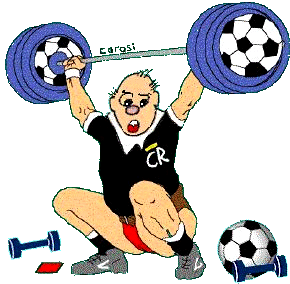 |
ARE YOU FIT ENOUGH TO START REFEREEING?
Preparing and Training…
Andrew Castiglione
Founder of Ken Aston Referee Society
 |
So just how fit does a Referee have to be for promotion?
GETTING STARTED
ACTIVITY 1:
CHECK YOUR WEIGHT
ACTIVITY 2:
CHEST/WAIST DIFFERENCE
ACTIVITY 3:
MEASURE YOUR BODY FAT
ACTIVITY 4:
FIND YOUR TARGET WEIGHT
ACTIVITY 5:
CALCULATE YOUR BODY-MASS-INDEX
ACTIVITY 6: TOE
TOUCH
ACTIVITY 7:
STANDING LONG JUMP
ACTIVITY 8:
RAISING THE CHEST
ACTIVITY 9:
PUSH-UPS
ACTIVITY 10:
SIT-UPS
ACTIVITY 11:
HOLDING YOUR BREATH
ACTIVITY 12: A
ONE MINUTE STEP TEST
FITNESS AWARENESS PROFILE
(Chart) |
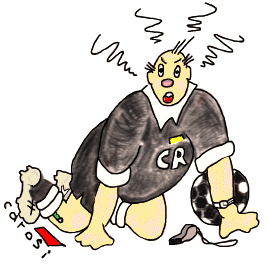 |
GETTING STARTED
You have completed your basic course of training to become a Referee,
taken the exam, and passed with flying colors. You are now one of the
elite. You are now one of your Football Association's Referees. In the
euphoria you readily agree to officiate your first game at the weekend.
As you proudly announce this to anyone who will listen somebody says
"Are you going to be fit enough to do it?" In anticipation of this great
day, of course you have been training hard for weeks, and the 6km or
more you will have to run at varying speeds and directions will not
cause you any problems at all. Will it? If you have been fairly active
recently you will probably be fine, but if you are taking up Refereeing
after a long lay off you will need to ascertain whether you are in good
enough condition before entering the field of play.
- You should
always get fit to... Referee and... NOT Referee to get fit.
- The older you are
and the longer you have not been involved in physical activity the more
care you must take before starting to Referee. Whatever your age the
amount of exercise you do should be carefully considered so you do not
suffer from undue fatigue or strain. After a bout of exercise you should
feel 'pleasantly tired' and not totally exhausted. If you do too much
too soon you will become fatigued and the results could be harmful.
Getting fit is a slow and gradual process and cannot be achieved
overnight.
- A medical check-up
should not be necessary before you start a fitness program. However, you
should start gently and gradually increase the amount of exercise you
take. Consult your doctor if you have any doubts about your health or if
you have a history of heart disease, high blood pressure, chest trouble
or aches and pains in your back or joints.
- Fitness is not an
exam, you cannot cram it all in at the end.
It is your responsibility as an
active Referee to attain and maintain a level of fitness appropriate to
the level at which you Referee.
Referee Fitness - Body Mass Index Guide is HERE!!!
ARE YOU FIT ENOUGH TO START REFEREEING?
You are now ready to start refereeing or you are returning to refereeing
after a long lay off and you want to find out how fit you are at the
moment without causing undue stress on your body. The Fitness
Awareness Profile can do just that, and can be carried out by
yourself at home.
The Fitness Awareness Profile measures the basic essentials of physical
fitness:
BODY WEIGHT; BODY FAT; FLEXIBILITY; MUSCULAR STRENGTH; MUSCULAR
ENDURANCE; HEART AND LUNG STAMINA.
It consists of twelve activities, each activity being graded A,
B, or C.
A - Means you have done very well.
B - Means you have reached a satisfactory level.
C - Means this is an aspect of your fitness that needs
to be improved.
Use your Fitness Awareness Profile Chart (at the end of this page) to
record your scores and tick the appropriate column. Hopefully, all of
your ticks will appear in the A and B columns, but if any appear in the
C column it would indicate an improvement is required. After a few weeks
you can test yourself again to see what improvements have been made.
The first five activities are concerned with your WEIGHT and the amount
of FAT you are carrying.
ACTIVITY 1: CHECK YOUR
WEIGHT
Use the Height/Weight Chart (just below)
to find out which category you are in. The chart can be used for men and
women as this is not a measure of body fat but of how much actual weight
you are carrying around the field of play.
Score:
A. - Your weight is within the Desirable range.
B. - You are into the Overweight category by up to 4kg
(9lb).
C. - You are into the Overweight category by more than
4kg (9lb).
Advice - It is important to weigh yourself regularly, especially if you
were in, or near, the overweight column. There is no need to weigh
yourself every day - once a week is quite sufficient - and if possible
you should use the same scales each time. Stand evenly on the scales and
wear the same amount of clothing each time, or better still wear nothing
at all. Your weight will fluctuate during the day so try to weigh
yourself at one particular time, either first thing in the morning or
just before you go to bed.
Tip - If you are into the Fat category you should try to lose some
weight before undertaking any strenuous exercise.
HEIGHT/WEIGHT CHART
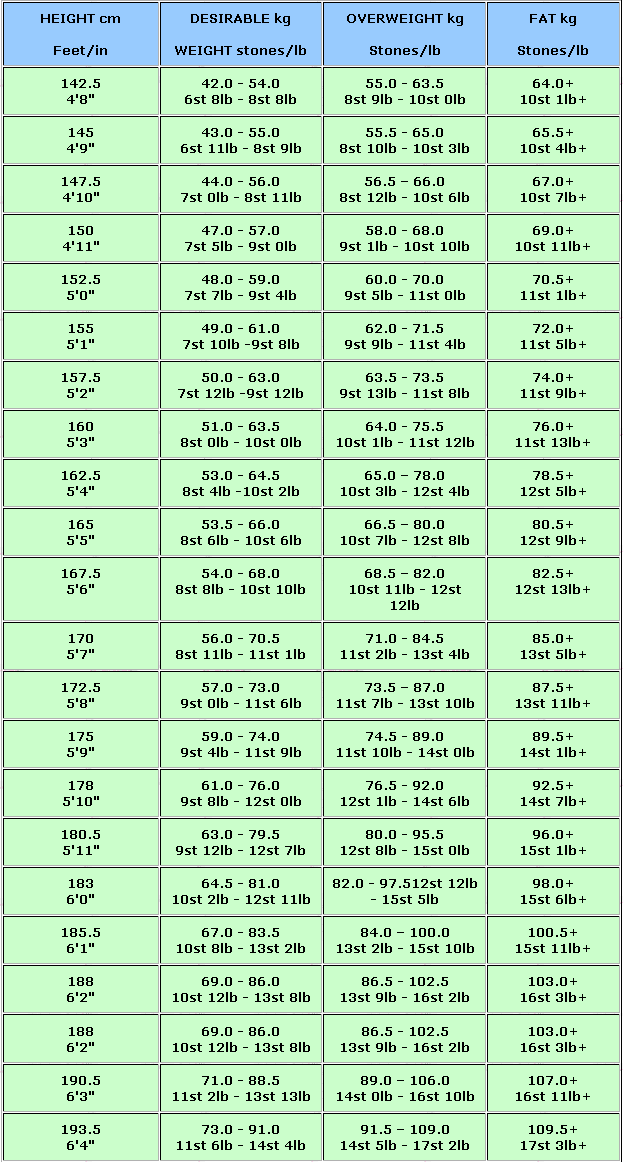
ACTIVITY 2: CHEST/WAIST
DIFFERENCE
Stand with your shoulders back and your chest fully expanded. Measure
the circumference of your chest just beneath your arm pits. Then measure
your waist at navel height, with your stomach in a relaxed position,
i.e. not sucked in or forced out.
Score:
Men
A. - Your chest measurement is 12.5cm (5in) greater
than your waist.
B. - Your chest measurement is between 5cm (2in) and
12.5cm (5in) greater than your waist.
C. - Your chest measurement is less than 5cm (2in)
greater than your waist - or your waist measurement is bigger than your
chest measurement.
Score:
Women
A. - Your chest measurement is 25cm (10in) greater than
your waist.
B. - Your chest measurement is between 12.5cm (5in) and
25cm (10in) greater than your waist.
C. - Your chest measurement is less than 12.5cm (5in)
greater than your waist - or your waist measurement is bigger than your
chest measurement.
Advice - If you are heavy but score A on this
activity it indicates you are probably muscular rather than fat. A score
of B or
C
would suggest some of that extra weight is fat.
Referee Fitness - Body Mass Index Guide is HERE!!!
ACTIVITY 3: MEASURE
YOUR BODY FAT
You can now analyze your fat content more closely. Too much fat tissue
is not beneficial to you as a referee, so if you can find out what
percentage of your body weight is actually fat, it could be a very
useful piece of information for you. Too much body fat can have a far
more detrimental effect on your performance than the ageing process, so
you should strive to ensure you do not carry more fat than is necessary.
- You
can't stop yourself getting older but you can stop yourself getting
fatter.
Fact - It is normal for an adult man to have about
10-20 per cent of his body weight as fat with 15 per cent usually
considered to be average. For an adult woman the average is between
23-25 per cent fat. Very fit and active people could be well below these
average figures.
Men - Measure the circumference of your neck, just
below your 'Adam's Apple', and your abdomen, at navel height. Go to the
BODY FAT PERCENTAGE CHART FOR MEN (below)
to find out your fat percentage.
Example:
Neck circumference is 38cm (15in)
Abdomen circumference is 84cm (33in)
Predicted Body Fat is 15%
Women - Measure the circumference of your neck and
abdomen as for the men. In addition measure the circumference of your
arm around the biceps, your forearm just below your elbow and your upper
thigh. See to the BODY FAT PERCENTAGE CHART FOR WOMEN
(below).
Find the points scored for each of your five circumferences. Add all the
points together and subtract 55. The figure you are left with is the
predicted percentage of body fat you are carrying.
Neck circumference is 30.5cm (12in)
Abdomen Circumference is 61cm (24in)
Arm (biceps) Circumference is 25.5cm (10in)
Forearm Circumference is 23.0cm (9in)
Thigh Circumference is 63.5cm (20in)
Total
8.0 points
5.5 points
11.0 points
33.5 points
20.0 points
78.0 points
Subtract 55 from the total (78 - 55 = 23)
Predicted body fat is... 23%
Score: Men
A 18% or under
B between 18% and 23%
C over 23%
Score: Women
A 23% or under
B between 23% and 26%
C over 26%
BODY FAT PERCENTAGE CHART FOR MEN
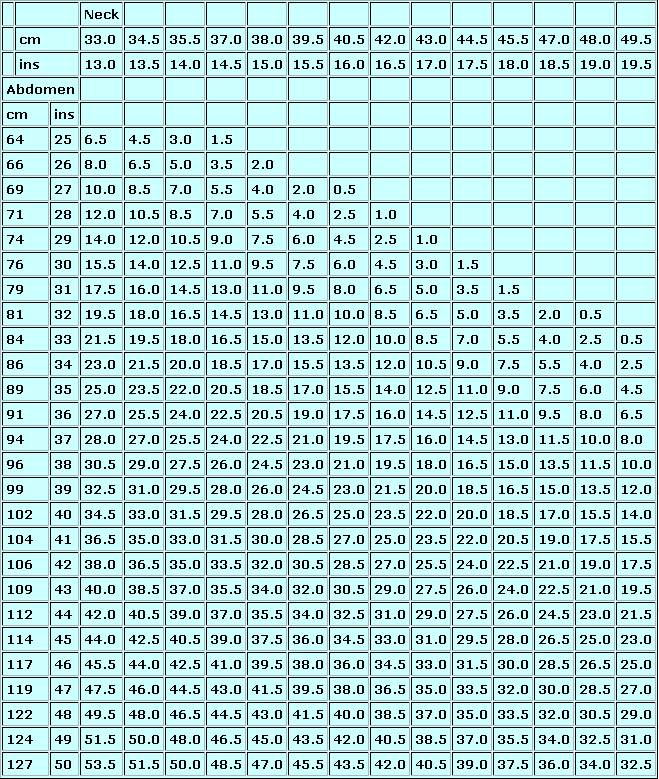
BODY FAT PERCENTAGE CHART FOR
WOMEN

Measure the circumference of your neck, abdomen, biceps, forearm and
thigh, in centimeters. Find the points scored for each of your 5
circumferences. Add them all together. Subtract 55 from the total. The
figure you are left with is the predicted percentage of body fat you are
carrying.
ACTIVITY 4: FIND YOUR
TARGET WEIGHT
Your Target Weight is based on the assumption that men have
approximately 15% body fat and women 23% body fat, and predicts what you
would weigh if you had that amount of fat and no more. Everybody needs
some fat on them to help insulate the body against cold and to act as a
secondary energy source. If you have more fat than is recommended it
means there is the opportunity to lose weight.
This is how you work it out.
STEP 1. Multiply your actual body weight by your body
fat percentage.
You weigh 73kg
(1601b) and you have 25% body fat
73 x 0.25 = 18.25kg of fat (160 x 0.25 = 40lb of fat)
STEP 2: Subtract your fat from your actual weight.
Example: 73 – 18.25 = 54.75kg (160 – 40 = 120lb)
This is what you should weigh if you had no fat at all.
STEP 3: To calculate your target weight divide your fat
free weight obtained in STEP 2 by 0.85 if your are a man and 0.77 if you
are a woman.
Men 54.75/0.85 = 64.5kg (120/0.85= 141 lb)
Women 54.75/0.77 = 71.0kg (120/0.77 = 156 lb)
(The reason you divide your weight by 0.85 and 0.77 is that these
figures represent the amount of fat you are allowed to have. If you
subtract 0.85 from 1.0 it leaves you with 0.15, which represents the 15%
fat men are allowed to have. Similarly for women 0.77 subtracted from
1.0 represents the 23% fat allowed.)
STEP 4:
You can now work out how much weight you should aim to lose by
subtracting your target weight from what you weigh at the moment.
Men 73 - 64.5 = 8.5kg (160 -141 = 19lb)
Women 73 – 71 = 2.0kg (160 – 156 =4lb)
Score:
A - You need to lose less than 2kg (5lb)
B - You need to lose between 2kg (5lb) and 7kg (15lb)
C - You need to lose over 7kg (15lb)
Referee Fitness - Body Mass Index Guide is HERE!!!
ACTIVITY 5: CALCULATE
YOUR BODY-MASS-INDEX
This will tell you whether or not you are the right weight for your
height.
Square your height in meters, write down the result.
Divide your body weight in kilograms by this number.
1.75 x 1.75 (height in meters) = 3.06
73kg (body weight) divided by 3.06 = 23.8
Score:
A - Your score is below 22
B - Your score is between 22 and 26
C - Your score is above 26
The next activity will measure your... FLEXIBILITY.
ACTIVITY 6: TOE TOUCH
Stand up straight and bend forward at the waist until your fingertips
reach the top of your toes or as near as possible to your toes.
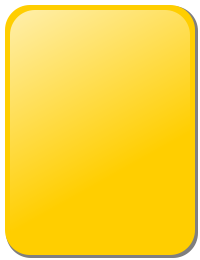 - Caution - If you have had a history of low back pain be very
careful with this particular exercise. In this case it would be better
if you sat on the floor with your legs out straight in front of you,
then bend forward from your waist to try and touch the top of your toes.
- Caution - If you have had a history of low back pain be very
careful with this particular exercise. In this case it would be better
if you sat on the floor with your legs out straight in front of you,
then bend forward from your waist to try and touch the top of your toes.
Score:
A - You can reach to within 2.5cm (1in) or less of your
toes.
B - You can reach to within 2.5cm (1in) and 12.5cm
(5in) of your toes.
C - There is more than 12.5cm (5in) between your
fingertips and your toes.
The next two activities measure your MUSCULAR STRENGTH.
ACTIVITY 7: STANDING
LONG JUMP
Stand still behind a mark and then jump forward as far as you can.
Score:
A - Your jump is more than 15cm (6in) greater than your
height.
B - You jump between 15cm (6in) less and 15cm (6in)
more than your height
C - Your jump is more than 15cm (6in) less than your
height.
ACTIVITY 8: RAISING THE
CHEST
Lie on your stomach and find some way of keeping your feet on the floor.
Perhaps someone can hold them down for you or you can wedge them under
the sofa or bed. Lace your fingers behind your head or keep your hands
off the floor and raise your chin as high as possible. It does help if
somebody else can measure how high you lift your chin, but if you are
doing this on your own you may find it easier to lie with your head
close to a wall so that you can quickly place your hand on the wall at
the level of your chin.
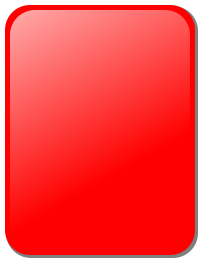 - Warning - Do not lift higher than 45cm (18in) or lift your
shoulders up quickly.
- Warning - Do not lift higher than 45cm (18in) or lift your
shoulders up quickly.
Score:
A - Your chin is over 38cm (15in) off the floor.
B - Your chin is between 8cm (3in) and 38cm (15in) off
the floor.
C - Your chin is less than 8cm (3in) oft the floor.
The next two activities measure your MUSCULAR ENDURANCE.
ACTIVITY 9: PUSH-UPS
Lie flat on the floor face down. Place your hands directly under your
shoulders. Keep your legs and back as straight as possible and push
upwards until your arms are also straight and your body has been lifted
clear of the floor. Now lower yourself back down to your starting
position. Do as many as you can up to a maximum of 25.
Score:
A - You do 20 or more.
B - You do between 6 and 19.
C - You do 5 or less.
ACTIVITY 10: SIT-UPS
Lie on the floor with your knees bent and your hands interlaced behind
your neck. Slowly curl up until your elbows touch your knees and then
return to the starting position. Do as many as you can but no more than
30.
-
Do not do this activity with your
legs out straight.
BEND YOUR KNEES.
Score:
A - You do 20 or more.
B - You do between 6 and 19.
C - You do 5 or less.
The last two activities measure HEART AND LUNG STAMINA.
ACTIVITY 11: HOLDING
YOUR BREATH
Breathe deeply two or three times and then hold your breath for as long
as is comfortable. There is no need to hold your breath for longer than
one minute.
Score.
A - You can hold your breath for over 50 seconds.
B - You can hold your breath for between 30 and 50
seconds.
C - You cannot hold your breath for longer than 30
seconds.
ACTIVITY 12: A ONE
MINUTE STEP TEST
For this activity you will need to take your pulse.
 - - To do
this, turn the palm of your hand towards the ceiling and lightly place
the first 3 fingers of the other hand on the bare wrist just above the
heel of the thumb.
- - To do
this, turn the palm of your hand towards the ceiling and lightly place
the first 3 fingers of the other hand on the bare wrist just above the
heel of the thumb.
Find a strong chair, stairs or firm box about 45cm (18in) high. Step up
and down 30 times in 1 minute so you complete one step every 2 seconds.
It may help to count ONE --TWO -- THREE -- FOUR, as you do it. At the
end of 1 minute SIT DOWN and find your pulse straight away (within 10
seconds).
Count the total number of beats you feel for the next 2 minutes.
Score:
A - Less than 200 beats counted in 2 minutes.
B - Between 200 and 240 beats counted in 2 minutes.
C - More than 240 beats counted in 2 minutes.
You have now completed your Fitness Awareness Profile, and by looking at
the ticks on your chart, you should have a picture of where you stand at
the moment.
 - - If you
have ticked an 'A' or 'B' in all columns you should be fit enough to
start Refereeing and to train regularly to improve your fitness level
still further.
- - If you
have ticked an 'A' or 'B' in all columns you should be fit enough to
start Refereeing and to train regularly to improve your fitness level
still further.
Activities where you scored 'C' indicate an improvement is needed. As
long as there are not too many in the 'C' category and you did not score
'C' for activities 11 or 12 there is no reason why you should not begin
training with a view to officiating at your first match when your
fitness profile has improved.
If you have scored mainly in the 'C' category, including a 'C' for
activities 11 and 12, your fitness level is low and you should undertake
exercise gradually, taking care not to do too much too soon.
(See section on 'Improving and Maintaining Fitness').
Return to your Fitness Awareness Profile after a few weeks to see what
improvements have been made.
FITNESS AWARENESS PROFILE
Record your actual scores in the first box
Today’s Date..._______
And tick the category... A, B or
C appropriate to your score... Be Honest!!!

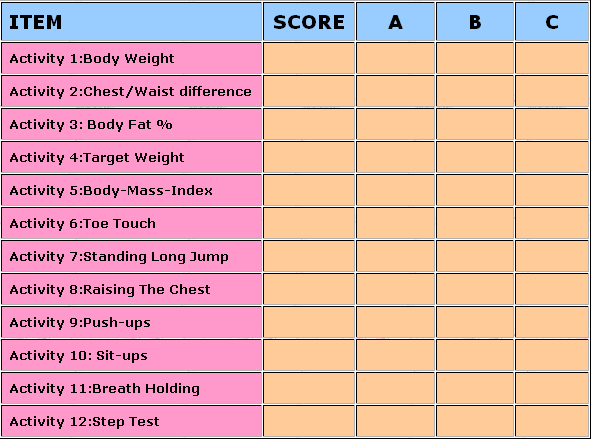
Source of information: 'A Guide to
Fitness for Referees' April 2001, produced by the Football Association
England. Acknowledgement to the National Coordinator for Fitness
Training, Vernon Crew; along with expert advice from John Brewer,
Director of the Lilleshall Sports Injury and Human Performance Center;
Alan Hodson, Director of the Football Association Medical Education
Center; and Rob Hartley, Head of the Sports Science Department,
University of Brighton.
The Document:
|